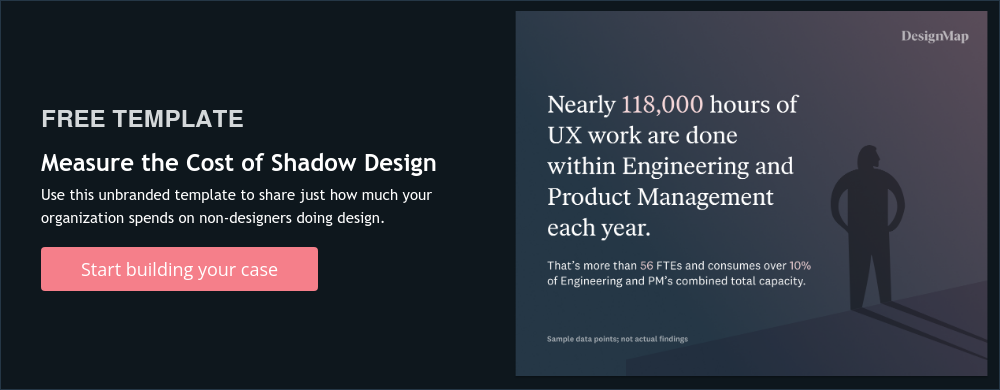Companies are spending millions of dollars on shadow design teams (aka non-designers doing design work). Is yours one of them? We've created a survey you can use at your organization to find out how much is being invested in bad design.
In part one of this series, we outlined levels of organizational design readiness—from Design Ignorant - Level 0 to Design Enlightened - Level 3. Companies at the highest level of design readiness are not just aware of and touting the merits of design. They are using design to shape strategy and build more resilient products and businesses.
But how can design advocates in the agreeable-but-not-enlightened tier help their organizations level up how they think about and use design? Like anything else, they need to make a solid case for investing in design.
We’ve seen many folks try (unsuccessfully) to do this by demonstrating the “value” or “ROI” of good design. And what we hear over and over is that people give it lip service, but they don’t give it…well, money.
It’s time to view this problem through a (radically) different lens and reframe the conversation. Let’s stop talking about investing more in design. It’s time to look at how you’re already spending money on design and spend it better.
Let’s call this what it is: folks are spending money on bad design. Dunning–Kruger tells us that, “people with low ability, expertise, or experience regarding a certain type of task or area of knowledge tend to overestimate their ability or knowledge.” How many Product Managers, Engineers, and Business Analysts are out there saying, “Pfft, don’t call it ‘bad design’ just because I’m not trained! I’m great at it!” How many of them are right? Certainly some, but I’m going to bet not all or even most.
In What CEOs Need to Know About Design, I advise leaders to run an internal survey to uncover where design is actually happening, how design is being paid for and—more importantly—where and how bad design is being paid for badly.
We saw an opportunity to put this survey into practice when BeyondTrust—a global leader in intelligent identity and access security—came to us with a (unfortunately common) case of a design investment gone slightly sideways.
Angela Duggan, VP of User Experience at BeyondTrust, knows how critical user experience is to software adoption—especially in the challenging world of developers building tools for developers (who needs design, right?). And she knew it was time to make the case for growing her already high-functioning user experience design team.
Together, we flipped the conversation from focusing on the value of good design to demonstrating the cost of shadow design (aka when a non-designer is doing the work). We developed a survey for engineering, product, marketing and other business functions to uncover the time and misallocation of resources being used to do UX and design work.

She used that to present a very simple and compelling case—not to invest more, but to take the same funds and invest them appropriately in trained and experienced designers.
When we do surveys like this with our clients, it is an understatement to say that we’re surprised by the results. We are consistently shocked to uncover how many hours non-designers are spending alone, doing design work, essentially being designers.
And when we add it up, how many full-time equivalents it amounts to. Imagine finding out that your designers were doing something like 20 full-time developers worth of code! How would that fly?
We’ve executed this survey with other organizations and the spend on non-designers doing design work has amounted to many millions of dollars. And yet, there is a very clear solution to put an end to this wasteful (and ineffective) spending.
We don’t need to argue to invest more money in design. We need to argue to invest in the current design spend well. It’s about the quality of the investment—not just the quantity.
And we want to help you do that—after all, raising the standards of design helps buyers, users, and the whole profession do better. So, we’re passing the survey on to you below.

We’ve also developed an unbranded template for you to synthesize and present the survey findings to the powers that be within your organization.

- Create a Google Forms copy of the Quantifying Shadow Design Survey here.
- Create a Google Slides copy of the Shadow Design Spend synthesis template here. Note: If you don’t have a Gmail account, you can download the template in your preferred format via this preview link (Click File > Download > Select your format of choice).
We’re proud to open source these resources with the support of BeyondTrust. I sat down with Angela to chat about why she decided to issue the survey, what she uncovered, and how her Design Enlightened team is creating intuitive experiences for our work-from-anywhere world.
Audrey: Angela! We were BeyondThrilled (see what I did there?) when you partnered with us to create this survey. Could you tell the good folks at home what led you to explore this approach?
Angela: Because BeyondTrust formed by merging several smaller companies together, the style was very “start-up”. Typically, with start-up culture, it’s very Engineering led and if any UX is present at all, it’s thought they’re there to “make things pretty”.
I wanted to change that narrative.
Luckily the CEO was familiar with UX and how important it is, especially for companies in mature markets. But I needed to reach the people leaders who were more in the weeds.
Throughout my career as an Experience Architect, I always found data is the easiest way to get people to truly understand and get onboard with UX’s approach. So, I started trying to figure out what kind of data I could gather to get my point across.
Audrey: That sounds very familiar. We hear from so many design advocates at B2B/B2B2C enterprises that they need data to demonstrate the shadow design problem. Did any of the survey findings surprise you?
Angela: I knew lots of design work was being done outside the UX department, but I wasn’t prepared for the sheer volume of design work being done by Product Management (PM) and Engineering. When I translated those hours to dollars, it became even more shocking.
Audrey: And how were the findings received overall? Any tips for other teams on how to successfully deliver what could be difficult news to an executive team?
Angela: First, I think you just need to stick to the facts. This many hours = this many dollars. Yes, it might be a difficult pill to swallow. But, if you follow that up with a solution, (aka if we spent even a fraction of that money on hiring UXers) you’d not only get better quality experiences in your product, your PM and Engineering resources would work more efficiently and get more done.
Plus, you’ll get validation through user research that you’re working on the right things and solving the customer’s problems in the right ways. It’s a win-win all the way around.
Audrey: Super helpful advice. Okay, so you deliver the results and everyone gets a better understanding of the problem. How did you turn those insights into action?
Angela: After delivering the message, I followed it up with an action plan for building a UX team. I broke that action plan into four phases instead of asking for it all at once, which made it easier to get the budget. Once you get a few UXers in there, you can easily show value, and it becomes easier to get support and budget to grow the team further.
The first phase should focus on the areas that need UX the most. This means you need to do some research. You need to befriend your Customer Support and Solution Engineering partners. They are prime resources to tell you where the experience falls down and where customers struggle the most.
You also need to get your PMs on board and working closely with your UXers. Once they get used to working with UX, they will see the value and they won’t want to go back.
Audrey: I’m sure it helps that BeyondTrust was already “design agreeable”, as we’d call them in our framework. Do you have any advice for someone who wants to advocate for design at an organization that is less design ready?
Angela: My advice would be: don’t forget about research. I think sometimes people want to start with hiring as many designers as they can, but just having designers makes it way more difficult to change the culture and prove real value.
Having researchers gather data makes a tremendous impact on your ability to get other departments onboard. They also can objectively validate design decisions so you know you’re solving the right problems in a way your users will understand.
Audrey: Anything else you’d like to add to help product-let teams maximize the impact of design? Especially with so many teams feeling stilted by the current economic climate…
Angela: Don’t forget to look down the mountain. I think we get so caught up in the next challenge, that mountain peak, that we forget to look back and see how far we’ve come.
Sometimes it can be demotivating when there is slow progress, still so far to climb, or worse, backsliding. But when you get the urge to throw your hands up and say “this is impossible” look back at what you’ve accomplished in the past six months or year. I bet you a year ago would be amazed at how far you’ve come and the UX maturity of your company now.
Connect with other UX leaders at different companies. I always find it comforting and motivating when I know others are facing similar challenges to mine and they’re overcoming them.
As far as this tough economic climate; this is prime time for UX to shine. When customers need to stretch their dollar, UX is going to be that differentiator between you and your competition. If customers are having to choose between your product and another, make it an easy choice for them.
A good in-product experience makes your product sticky for existing customers and makes it easier for prospects to see immediate value.
Audrey: Hear, hear! Innovation happens not just in spite of, but sometimes because of difficult times. We hope other teams will follow BeyondTrust’s lead and embrace the role of design as a way to build more resilient products.
Get in touch if you need help making the case for design as a means to a more strategic, purposeful future.

